Cherry - this is the oldest variety of cherries, it was grown 8 thousand years BC, as evidenced by archaeological finds. These juicy and sweet berries are popular these days, they are eaten fresh, cooked in compotes and boiled jam. How to grow a plentiful crop on your site, choose the right variety, prune, read the article.
Material Content:
The best varieties of cherries for growing in the garden
When choosing sweet cherry seedlings in the nursery, it is important to choose the right variety, it must be zoned, suitable for the growing region. Southern species should not be planted in the cold climate of central Russia.

Popular varieties:
- "Tyutchevka" - a dessert variety, bears fruit very abundantly, the berries are juicy and sweet, dark red;
- “Revna” - large dark red berries, good dessert taste (4.9 points), “Revna” cherries refers to medium-late varieties;
- "Teremoshka" - light red berries, sweet;
- “Bryanochka” - fruitful, late variety, drought-resistant and frost-resistant, red fruits;
- "Veda" - large-fruited cherries with dark red, juicy berries;
- "Milana" - red berries, frost-resistant, high productivity;
- "Red Hill" is an early variety, the berries are delicious even immature, large and red.
- “Fatezh” - a quick-growing variety, berries with a yellow basic color and pink blush, weighing about 6 g, the flesh is juicy, elastic, the bone separates easily, the “Fatezh” sweet cherry tastes good (4.7 points);
- “Fariza” - late variety, yellow-orange fruits;
- “White Winklera” - yellow berries, weighing up to 12 g, late variety, withstands frosts of -30 ° C;
- "Bryansk pink" - pink-orange fruits, late ripening;
- "Yellow Sayan" - the yellow fruits begin to ripen in early August:
- "Drogana yellow" is an old variety with high winter hardiness, abundantly bears fruit.
- “Iput” - the variety ripens in the first half of summer, the berries are dark red, juicy, fragrant, weighing from 5 to 10 g. “Iput” sweet cherry has an excellent taste (4.5 points).
To date, about 4 thousand varieties of cherries have been bred. All of them are divided into two large groups, which are called bigarro and gini.
Bigarro varieties have large fruits with elastic, crispy flesh. They are most often of medium and late ripening, suitable for fresh consumption and for canning.
Gini are early cherries with juicy and sweet pulp, but they are not suitable for canning, poorly stored, they are eaten fresh.
Outdoor landing

Seedlings are bought in the nursery in order to know exactly what will grow. Container plants with a well-developed root system are chosen.
Timing and landing scheme
Most varieties of cherries are tall, mature trees grow up to 10 meters, they have a wide crown. This must be taken into account when planting in the garden, giving each seedling enough space for growth and development.
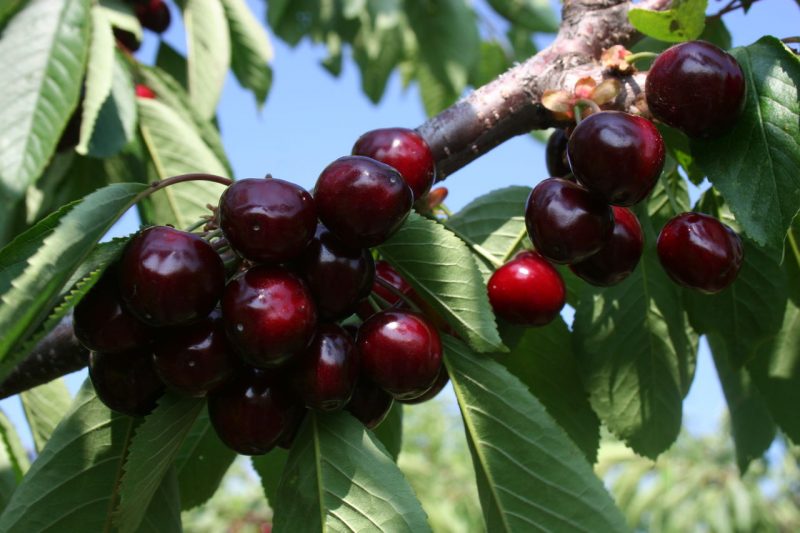
The distance between adjacent plants should be at least 5 meters.
It is best to plant cherries in the spring so that the seedlings take root with 100% probability. In the south of Russia, where mild winters, you can plant a tree in the fall.
Soil preparation and location
You should always start landing with a choice of place. Cherry likes well-lit areas and fertile soils. It grows poorly on heavy clay soil. The place must be protected from strong winds.
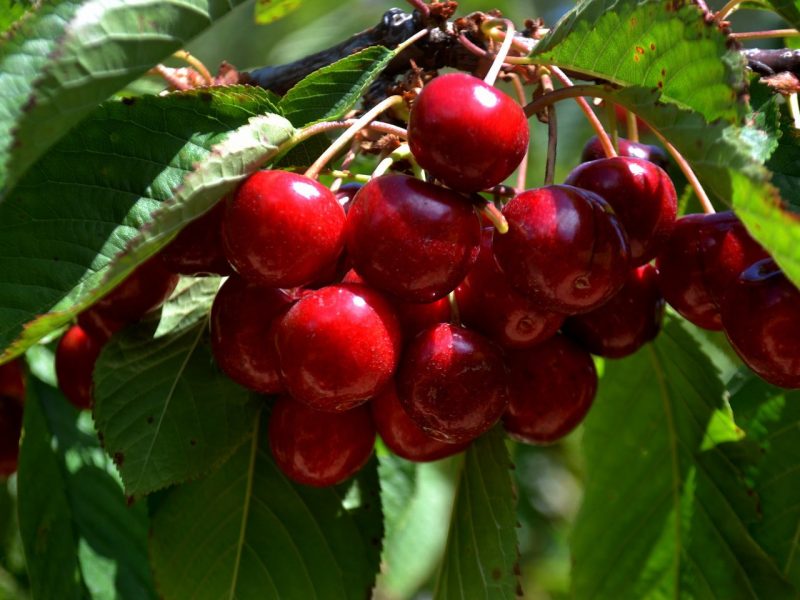
For a seedling purchased in a container, a pit is made 20 cm larger than the diameter of the container in which it grows, and 20 cm deeper. Having moved the tree to the hole, the remaining space in it is filled with fertile soil mixed with a bucket of humus.
When planting in August, adding mineral fertilizers to the well is undesirable. They can cause intense growth, and freezing of young shoots.
The root neck of the tree should be at the level of the soil, it cannot be deepened, it can even be raised 5 cm above the ground. After watering, the seedling will settle slightly, at least 20 liters of water are poured under the cherry, and mulch the soil.
Sweet Cherries: Outdoor Care
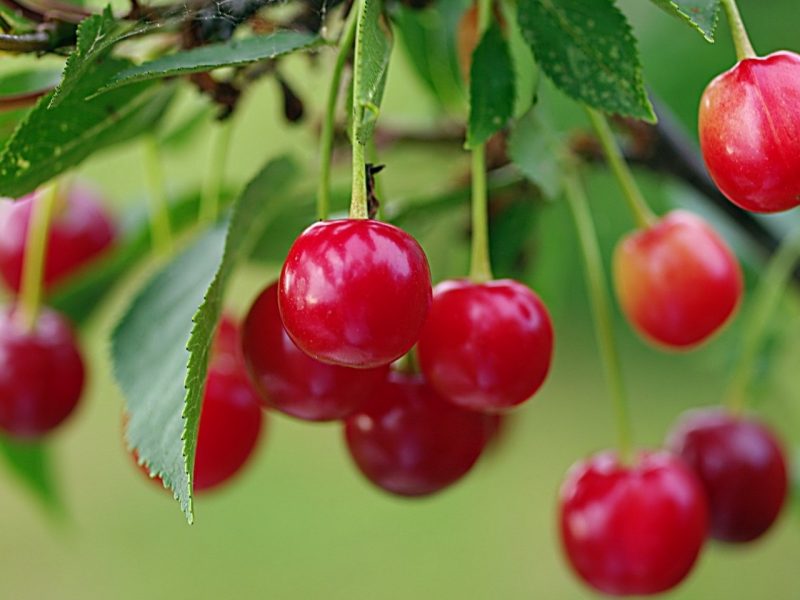
Tree care consists of watering, fertilizing, pruning, loosening the soil in the tree circle and protecting against pests.
It is interesting:how to grow jealous cherries
Watering schedule
It is convenient to organize drip irrigation for cherries. It is important for her that the soil is moist all the time. Regular watering during crop formation is especially important. If the earth is dry, after heavy rains the fruits begin to crack.
Feeding and wood processing
If there is not enough calcium in the soil, gum therapy can begin. When planting in a hole, it is advisable to immediately add dolomite flour, wood ash or fertilizer with trace elements (without nitrogen), which contains calcium and magnesium.
In early spring, you can water the cherries with a solution of urea, if the seedling grows weakly. When the tree begins to bear fruit, top dressing should be done regularly. They make complex fertilizers (Kemiru, Fertiku, etc.) 2 times per season - in spring and summer.
Forming pruning cherries in spring and autumn
There are different opinions on how sweet pruning should be done in spring and autumn. Some gardeners prefer to grow tall trees. If the sweet cherry seedlings do not have a leading central shoot, correct this with forming pruning. Leave 1 shoot central (can be attached to the guide support), and the second is shortened, making subordinate.

The first pruning is best done in spring. Until the cherry starts to bear fruit, cut off 1/5 of all shoots. There are special crown pruning technologies called “Spanish bush”, “Australian bush” and “KGB”, in which the tree is shaped in the form of a bush.
For the "Australian bush" begin to form a one-year-old seedling, cutting it at a height of 45-50 cm from the soil surface. From the lateral buds, shoots begin to grow, which are sent to the sides. Only 4 top shoots are left on the trunk, the bottom ones are removed. After 2 years, the ends of the shoots are cut to begin branching.
On the cherries they still make a sparse-tiered formation. With this method, the trees are tall, it is difficult to harvest, protect them from birds, and process them from pests.
Fruiting and pollinators
The sweet cherry begins to bear fruit 3 years after planting, but abundant harvests can only be harvested in the 10th year.
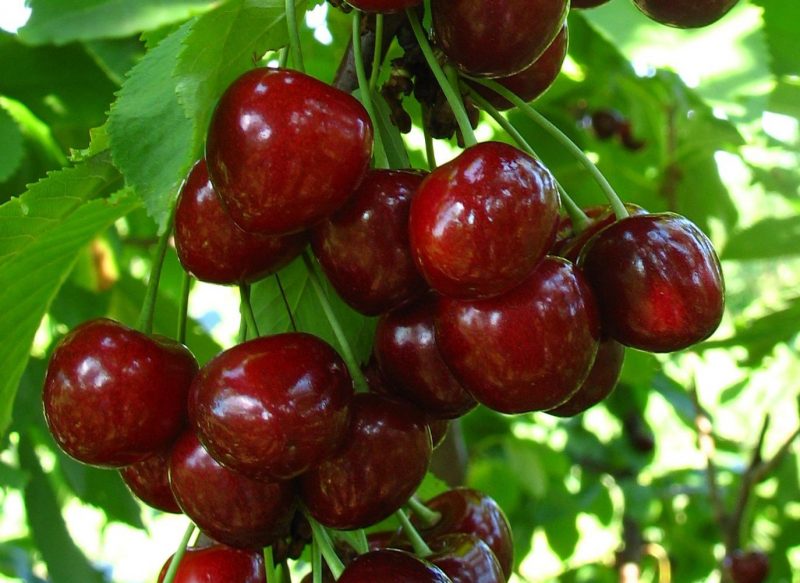
Bees are pollinated with cherry. Most varieties are self-fertile; for good fruiting, it is necessary that other varieties blooming at the same time grow nearby. Cherry well pollinates cherries.
Harvest is important not only to grow, but also to maintain. A flock of birds can destroy all ripened fruits in 30 minutes. You can protect the crop by pulling a grid on the tree.
Preparing for the winter
The tree in the autumn needs to be helped to prepare for winter, for this it is fertilized. In August, 2-3 tbsp. l superphosphate per 1 m2 of crown projection.

In addition to top dressing, prophylactic pruning of the crown is carried out, all diseased and weakened shoots are cut and burned.
The trunk circle is dug up to a depth of about 10 cm, mulched and watered if there is no rain. In autumn, at least 10 buckets of water must be added under each tree so that the soil does not freeze.
Pest and Disease Control

Cherry is characterized by such diseases:
- Coccomycosis - small brown spots that gradually expand, merge, damaged leaves turn yellow and fall off.
- Moniliosis - separate branches dry on the cherry. It is advisable to immediately cut and burn them, and treat the plant with a Bordeaux mixture (1%). You can not spray the plant when the fruits ripen, this is done immediately after flowering or harvesting.
- Kleasterosporiosis or perforated spotting - it affects leaves and shoots. The branches begin to dry out, gum flows from them, and the plant weakens.
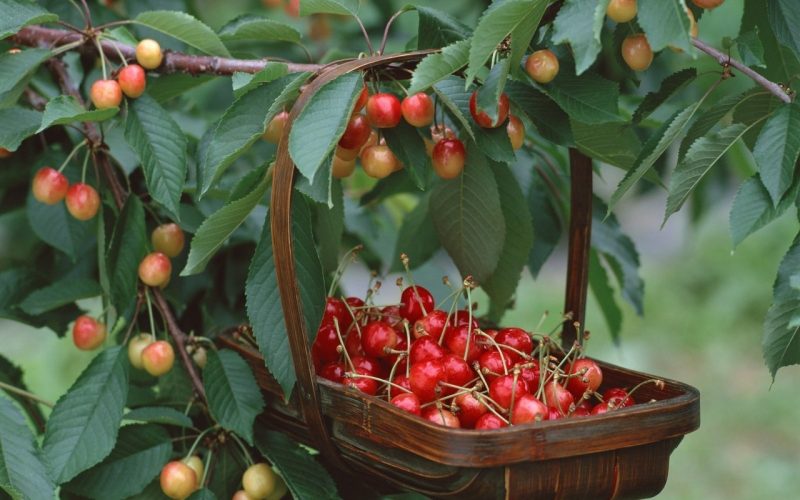
Cherry pests:
- black aphids;
- cherry fly;
- american butterfly.
To prevent diseases and pests, trees are treated with fungicides and insecticides in early spring before buds open and in autumn, after harvesting from late varieties.
Cherry can easily be grown in central Russia; there are many frost-resistant varieties that are not inferior in taste to southern berries. The methods of forming in the form of a bush allow you to collect a large crop and facilitate care.












